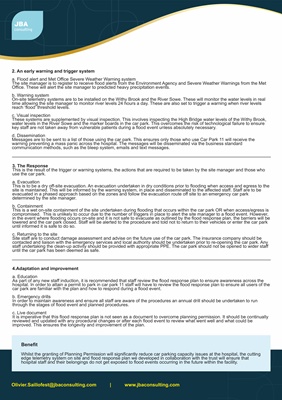
olivier.saillofest@jbaconsulting.com | www.jbaconsulting.com
Benefit
Whilst the granting of Planning Permission will significantly reduce car parking capacity issues at the hospital, the cutting
edge telemetry system on site and flood response plan we developed in collaboration with the trust will ensure that
hospital staff and their belongings do not get exposed to flood events occurring in the future within the facility.
2. An early warning and trigger system
a. Flood alert and Met Office Severe Weather Warning system
The site manager is to register to receive flood alerts from the Environment Agency and Severe Weather Warnings from the Met
Office. These will alert the site manager to predicted heavy precipitation events.
b. Warning system
On-site telemetry systems are to be installed on the Withy Brook and the River Sowe. These will monitor the water levels in real
time allowing the site manager to monitor river levels 24 hours a day. These are also set to trigger a warning when river levels
reach 'flood' threshold levels.
c. Visual inspection
These systems are supplemented by visual inspection. This involves inspecting the High Bridge water levels of the Withy Brook,
water levels in the River Sowe and the marker boards in the car park. This overcomes the risk of technological failure to ensure
key staff are not taken away from vulnerable patients during a flood event unless absolutely necessary.
d. Dissemination
Messages are to be sent to a list of those using the car park. This ensures only those who use Car Park 11 will receive the
warning preventing a mass panic across the hospital. The messages will be disseminated via the business standard
communication methods, such as the bleep system, emails and text messages.
3. The Response
This is the result of the trigger or warning systems, the actions that are required to be taken by the site manager and those who
use the car park.
a. Evacuation
This is to be a dry off-site evacuation. An evacuation undertaken in dry conditions prior to flooding when access and egress to the
site is maintained. This will be informed by the warning system, in place and disseminated to the affected staff. Staff are to be
evacuated in a phased approach based on the zones and follow the evacuation route off site to an emergency car park
determined by the site manager.
b. Containment
This is a wet on-site containment of the site undertaken during flooding that occurs within the car park OR when access/egress is
compromised. This is unlikely to occur due to the number of triggers in place to alert the site manager to a flood event. However,
in the event where flooding occurs on-site and it is not safe to evacuate as outlined by the flood response plan, the barriers will be
lowered and the car park closed. Staff will be alerted to the procedure and told not to return to their vehicles or enter the car park
until informed it is safe to do so.
c. Returning to the site
Site staff are to conduct damage assessment and advise on the future use of the car park. The insurance company should be
contacted and liaison with the emergency services and local authority should be undertaken prior to re-opening the car park. Any
staff undertaking the clean-up activity should be provided with appropriate PPE. The car park should not be opened to wider staff
until the car park has been deemed as safe.
4.Adaptation and improvement
a. Education
As part of any new staff induction, it is recommended that staff review the flood response plan to ensure awareness across the
hospital. In order to attain a permit to park in car park 11 staff will have to review the flood response plan to ensure all users of the
car park are familiar with the plan and how to respond during a flood event.
b. Emergency drills
In order to maintain awareness and ensure all staff are aware of the procedures an annual drill should be undertaken to run
through the stages of flood event and planned procedures.
c. Live document
It is imperative that this flood response plan is not seen as a document to overcome planning permission. It should be continually
reviewed and updated with any procedural changes or after each flood event to review what went well and what could be
improved. This ensures the longevity and improvement of the plan.